The race for artificial intelligence supremacy between the United States and China has emerged as one of the most consequential technological competitions of our time. This comprehensive analysis examines the multifaceted dimensions of this rivalry, from government strategies and corporate innovation to ethical approaches and future trajectories. As these two superpowers invest billions in developing AI capabilities, their competition is reshaping global technology landscapes, economic systems, and geopolitical relationships.
National AI Strategies and Policies
US and China have developed comprehensive national strategies to advance artificial intelligence capabilities
The United States and China have adopted distinctly different approaches to artificial intelligence development at the national level, reflecting their respective governance systems and strategic priorities.
United States
The US approach to AI development is characterized by a blend of government coordination and private sector leadership. The American AI Initiative, launched in 2019, and the National AI Initiative Act of 2020 established a framework for federal AI research and development. The Biden Administration has further strengthened this approach with the 2023 Executive Order on Safe, Secure, and Trustworthy AI, which emphasizes responsible innovation.
Key elements of the US strategy include:
- Sustained federal R&D funding across multiple agencies (DARPA, NSF, DOE)
- Public-private partnerships to accelerate innovation
- Sector-specific regulatory frameworks rather than comprehensive legislation
- Strong emphasis on maintaining technological leadership for national security
- Focus on developing AI standards and promoting democratic values in AI governance
China
China’s approach is more centralized and state-directed. The New Generation Artificial Intelligence Development Plan, launched in 2017, outlines China’s roadmap to become the world leader in AI by 2030. This plan is integrated with other initiatives like Made in China 2025 and China Standards 2035.
Key elements of China’s strategy include:
- Massive government funding and subsidies for AI development
- Integration of civilian and military AI applications (“Military-Civil Fusion”)
- Creation of national AI innovation platforms led by tech giants
- Comprehensive regulatory framework including the 2022 AI Governance Measures
- Strategic focus on specific AI domains where China can achieve leadership
While the US approach leverages America’s strengths in fundamental research and private sector innovation, China’s strategy benefits from coordinated policy implementation and the ability to mobilize resources toward strategic priorities. Both approaches have yielded significant advances, though in different domains of artificial intelligence technology.
Core AI Industries and Companies
Leading AI companies from the US and China are driving innovation across multiple sectors
The artificial intelligence landscape in both countries is dominated by technology giants and specialized AI firms that have emerged as global leaders in various domains.
US AI Leaders
- Google/Alphabet (DeepMind): Pioneer in general AI research and applications
- OpenAI: Leading generative AI with GPT models
- NVIDIA: Dominates AI hardware with advanced GPUs
- Microsoft: Strong in cloud AI and enterprise solutions
- Amazon: Leader in cloud AI services and applications
- Meta: Advanced research in computer vision and NLP
China AI Leaders
- Baidu: China’s leader in autonomous driving and NLP
- Alibaba: Dominant in e-commerce AI and cloud services
- Tencent: Strong in social media AI and gaming
- SenseTime: World leader in computer vision and facial recognition
- iFlytek: Specializes in voice recognition and translation
- Megvii: Advanced computer vision applications
Industry Focus Areas
- US Strengths: General AI research, cloud AI, enterprise solutions, generative AI, semiconductor design
- China Strengths: Computer vision, facial recognition, surveillance systems, voice recognition, manufacturing AI
- Competitive Areas: Autonomous vehicles, healthcare AI, smart cities, natural language processing
The US ecosystem benefits from deep integration between academia, startups, and established tech giants, creating a dynamic environment for innovation. China’s ecosystem features closer alignment between corporate objectives and national strategic priorities, with significant government support for designated “national champions” in artificial intelligence development.
“The US and China have developed complementary strengths in AI. While US companies lead in foundational models and research, Chinese firms have excelled at rapid application deployment and scaling in specific domains.”
Strengths and Weaknesses
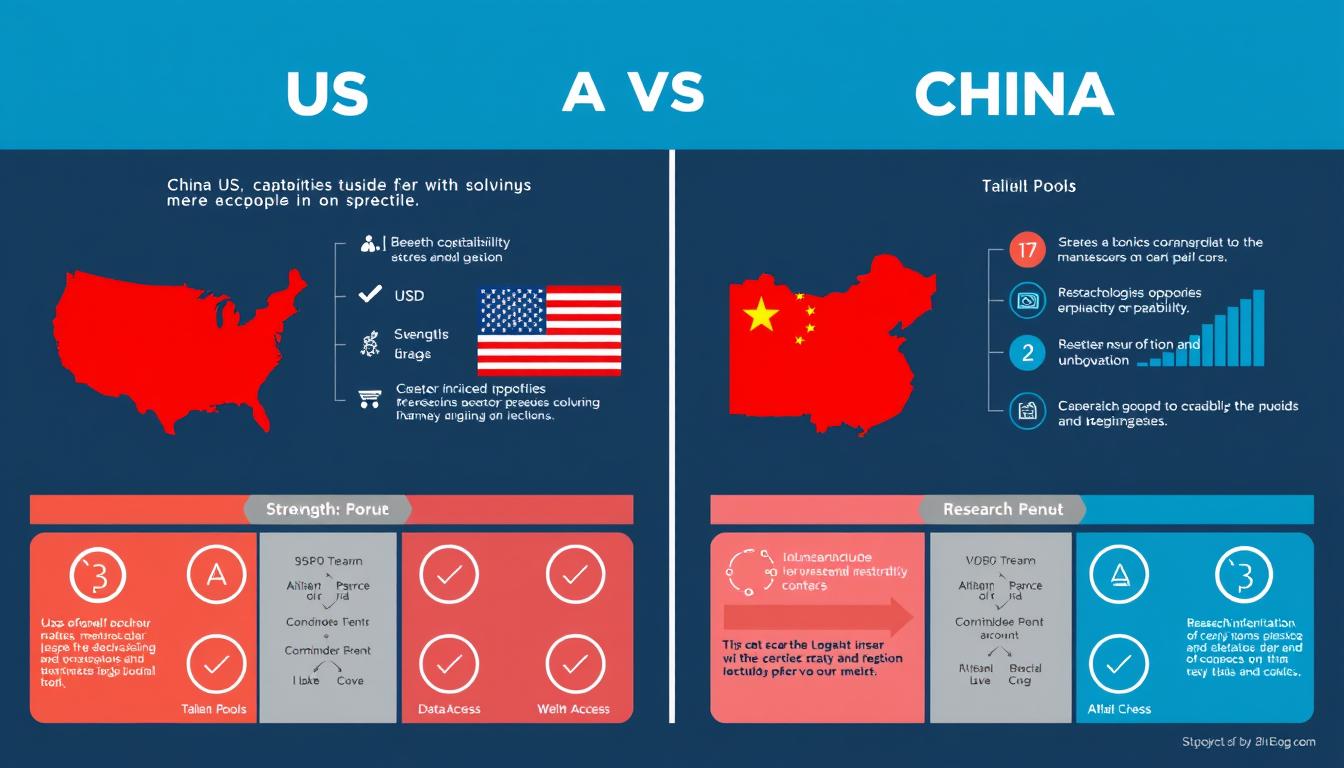
Comparative analysis of US and China artificial intelligence capabilities across key dimensions
United States Strengths
- Global leadership in fundamental AI research and innovation
- Unmatched semiconductor design capabilities (NVIDIA, AMD, Intel)
- World’s top AI research institutions and talent pipeline
- Dominant venture capital ecosystem for AI startups
- Strong tradition of open research collaboration
- Leadership in generative AI and large language models
United States Weaknesses
- Fragmented national AI strategy implementation
- Regulatory uncertainty creating innovation barriers
- Growing public skepticism toward AI applications
- Declining STEM education performance relative to competitors
- Limited manufacturing capacity for AI hardware
- Data privacy restrictions limiting some AI applications
China Strengths
- Massive data advantages from 1.4 billion population
- Strong government coordination and funding
- Rapid deployment and scaling of AI applications
- World-leading computer vision and facial recognition
- Growing semiconductor manufacturing capabilities
- Integration of AI across public infrastructure
China Weaknesses
- Gap in fundamental AI research capabilities
- Dependence on foreign semiconductor technology
- Limited international collaboration opportunities
- Brain drain of top AI talent to Western institutions
- Restricted access to cutting-edge AI research platforms
- International concerns about privacy and surveillance
The comparative analysis reveals that the United States maintains advantages in fundamental research, talent, and semiconductor design, while China excels in data availability, application deployment, and government coordination. These complementary strengths have led to different artificial intelligence development trajectories, with the US leading in general AI capabilities and China focusing on specific application domains.
Innovation and Research
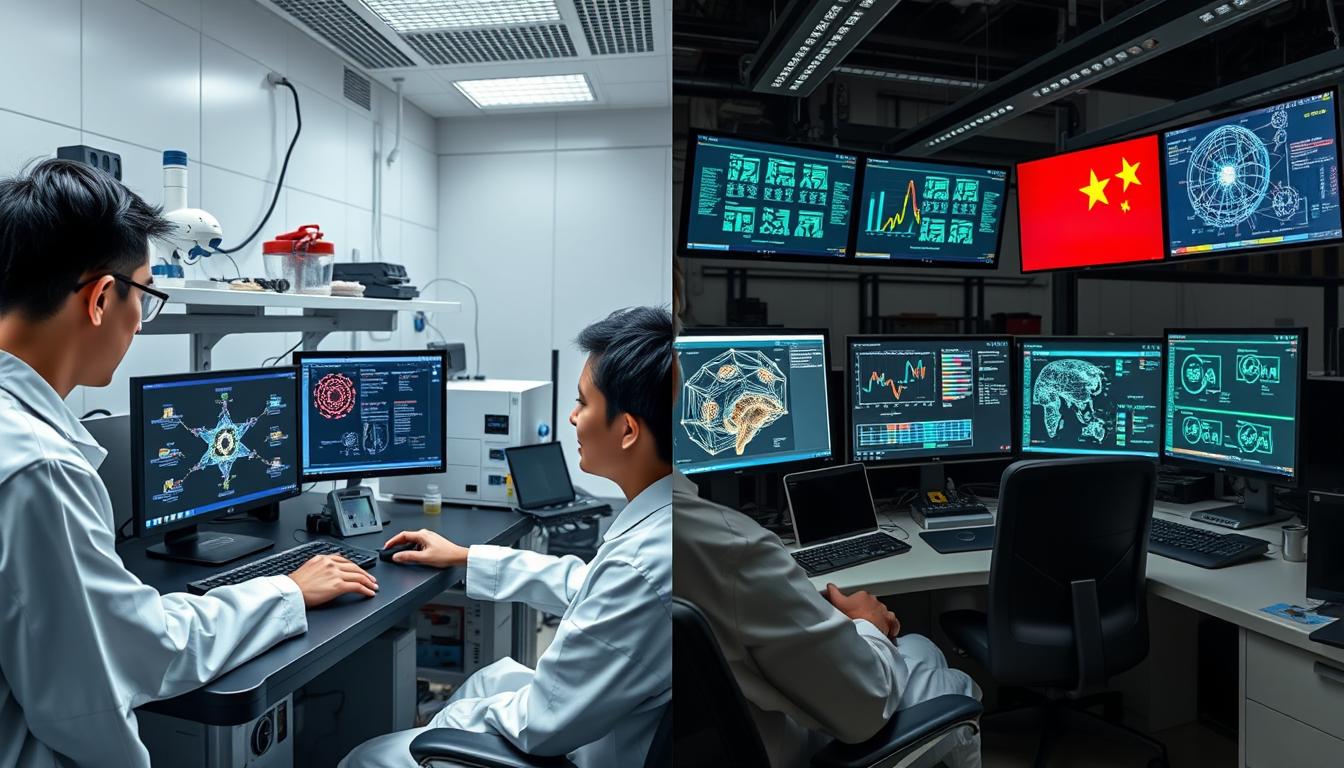
Research capabilities in artificial intelligence differ significantly between the US and China
Research output and innovation metrics reveal distinct patterns in how the US and China approach artificial intelligence development, with important implications for their competitive positions.
Research Publications
Both countries have dramatically increased their AI research output over the past decade, though with different emphases. According to the Stanford AI Index, China surpassed the US in raw number of AI journal publications in 2017, but the US maintains a lead in highly-cited research and at top conferences.
US Research Strengths
- Fundamental AI theory and algorithms
- Generative AI and large language models
- Reinforcement learning techniques
- Ethical AI and fairness research
- Multimodal AI systems
China Research Strengths
- Computer vision and image recognition
- Speech recognition and synthesis
- Applied AI for manufacturing
- Autonomous systems
- AI for healthcare diagnostics
Patents and Intellectual Property

China has surpassed the US in raw artificial intelligence patent applications, though questions remain about patent quality
China has taken the global lead in raw AI patent applications, filing 37% of all AI patents worldwide in 2022 compared to 32% from the US. However, analysis by the Center for Security and Emerging Technology (CSET) suggests that US patents tend to be more original and influential, with higher citation rates and commercial application.
Breakthrough Technologies
| AI Domain | US Breakthroughs | China Breakthroughs |
| Large Language Models | GPT-4 (OpenAI), Claude (Anthropic), Gemini (Google) | GLM-4 (Zhipu AI), Baichuan-13B |
| Computer Vision | DALL-E 3, Midjourney | SenseTime facial recognition, Megvii Face++ |
| Autonomous Vehicles | Waymo, Cruise, Tesla FSD | Baidu Apollo, AutoX |
| AI Chips | NVIDIA H100, Google TPU v4, Cerebras WSE-2 | Huawei Ascend 910, Cambricon MLU370 |
| Healthcare AI | Google DeepMind AlphaFold, Mayo Clinic AI diagnostics | Ping An Good Doctor, Infervision |
The innovation landscape reveals that the US maintains leadership in fundamental artificial intelligence research and cutting-edge applications like generative AI, while China has achieved significant breakthroughs in applied domains like computer vision and speech recognition. This pattern reflects their different strategic approaches and relative strengths in utilizing large amounts of data, deep learning, and neural networks to tackle complex tasks. Today, advancements in machine learning and algorithms enable both nations to process information and patterns more efficiently, impacting industries like self-driving cars and natural language processing.
Ethics, Regulation, and Privacy
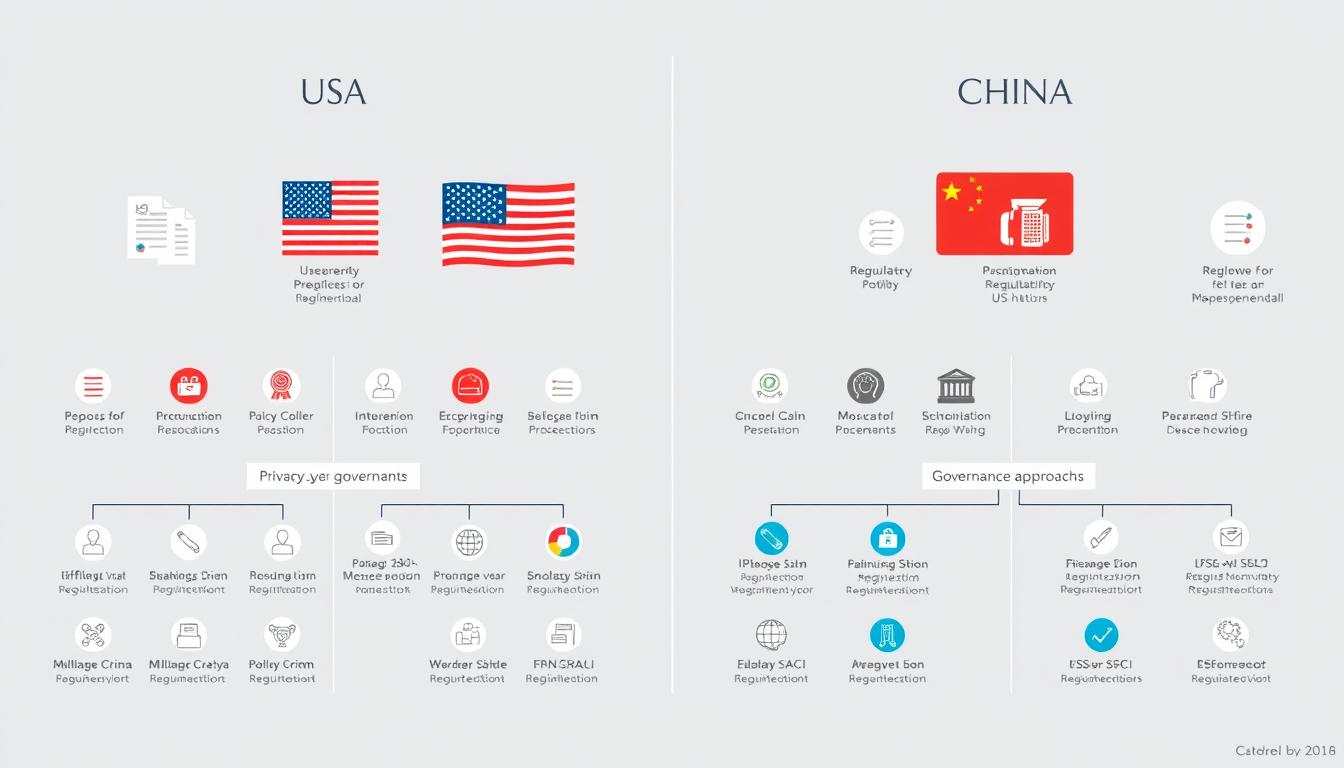
US and China have developed distinctly different approaches to artificial intelligence ethics and regulation
The regulatory approaches to artificial intelligence in the US and China reflect fundamentally different value systems and governance models, with significant implications for how AI technologies develop in each country.
US Regulatory Approach
The United States has adopted a largely sector-specific, risk-based approach to AI regulation, emphasizing voluntary guidelines and industry self-regulation. Key elements include:
- Blueprint for an AI Bill of Rights (2022): Non-binding guidelines emphasizing safe systems, algorithmic discrimination protection, data privacy, transparency, and human alternatives
- Executive Order on Safe, Secure, and Trustworthy AI (2023): Establishes safety standards for critical AI systems and promotes responsible government use
- NIST AI Risk Management Framework: Voluntary guidelines for organizations to manage AI risks
- Sector-specific regulations: FDA guidelines for AI in healthcare, financial regulations for AI in banking
- State-level initiatives: California, Colorado, and other states implementing their own AI regulations
China Regulatory Approach
China has implemented a more comprehensive, centralized regulatory framework for AI, with mandatory requirements and strong government oversight. Key elements include:
- Generative AI Regulations (2023): Requires registration, content moderation, and alignment with “socialist values”
- AI Ethics Specifications: National standards for ethical AI development
- Algorithm Registration System: Mandatory registration of recommendation algorithms
- Data Security Law and Personal Information Protection Law: Comprehensive data governance framework
- Facial Recognition Limitations: Recent restrictions on certain commercial uses
Privacy Considerations
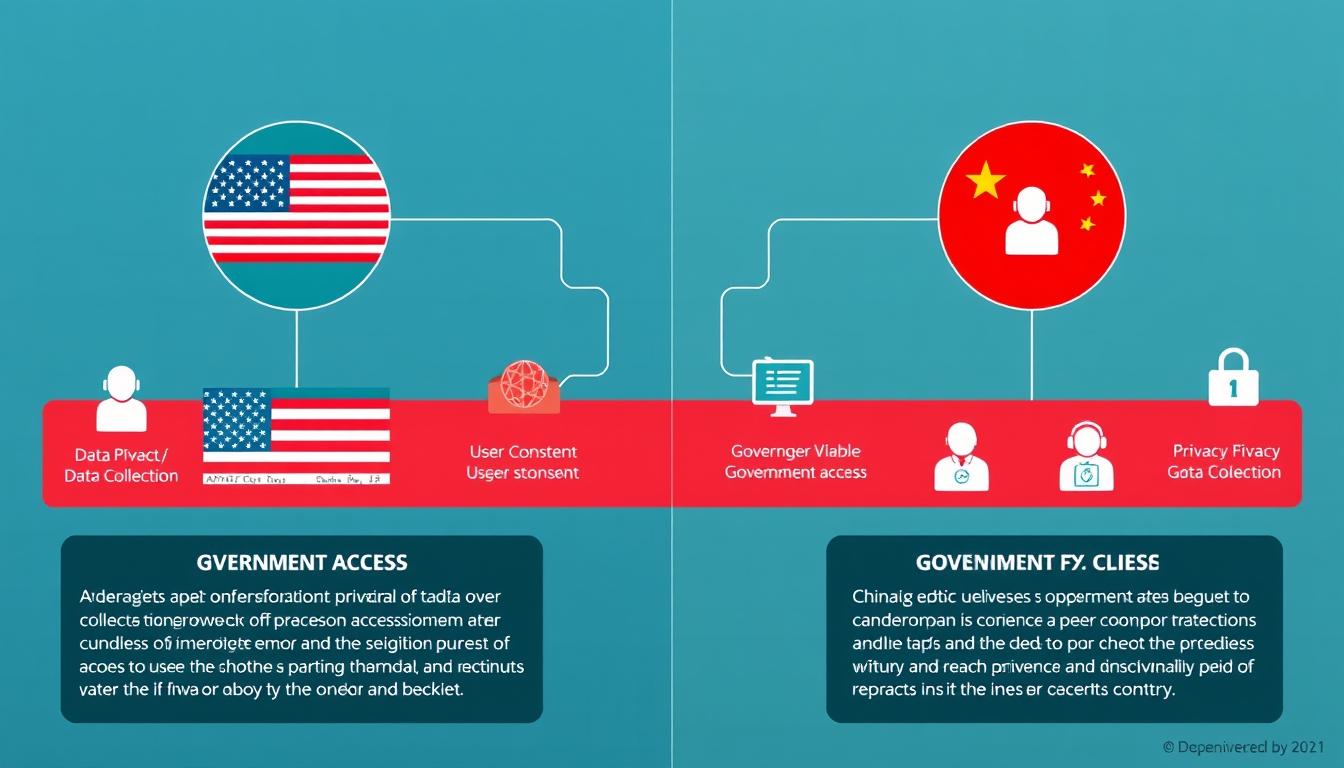
Data privacy frameworks significantly impact artificial intelligence development trajectories
Privacy frameworks in both countries significantly impact how AI systems are developed and deployed:
US Privacy Framework
- Sectoral privacy laws (HIPAA, GLBA, COPPA)
- State laws like CCPA/CPRA providing broader protections
- Emphasis on user consent and data minimization
- Judicial oversight of government data access
- Growing movement toward comprehensive federal privacy law
China Privacy Framework
- Comprehensive PIPL similar to GDPR in structure
- Strong data localization requirements
- Differential privacy protections for commercial vs. state uses
- National security exceptions for data access
- Strict cross-border data transfer restrictions
“The US and China represent divergent models of AI governance – one emphasizing innovation with guardrails, the other prioritizing control and alignment with state objectives. These different approaches will shape not just AI development but the global digital order.”
These contrasting regulatory philosophies create different innovation environments. The US approach provides greater flexibility for experimentation but may allow harmful applications to develop before regulation catches up. China’s approach provides clearer guidelines but may constrain certain types of innovation while enabling others that align with state priorities.
Investment and Funding

Investment patterns in artificial intelligence reveal different funding priorities and mechanisms
The scale and sources of AI investment differ significantly between the US and China, reflecting their distinct economic systems and strategic approaches.
Venture Capital and Private Investment
| Investment Metric (2023) | United States | China |
| Total AI Venture Capital | $48.8 billion | $13.4 billion |
| Number of AI Startups Funded | 1,650+ | 420+ |
| Average Deal Size | $29.6 million | $31.9 million |
| AI Unicorns (>$1B valuation) | 43 | 19 |
| Corporate AI R&D | $25.3 billion | $14.7 billion |
The US maintains a significant advantage in private AI investment, with venture capital funding nearly four times that of China in 2023. This gap has widened since 2021, partly due to increased restrictions on Chinese tech companies and growing investor enthusiasm for generative AI startups in the US, which leverage large amounts of data and advanced deep learning techniques, including deep neural networks and natural language processing. These innovations are critical in the industry today, assisting in the development of image models and intelligent assistants that power various products, including self-driving cars.
Government Funding
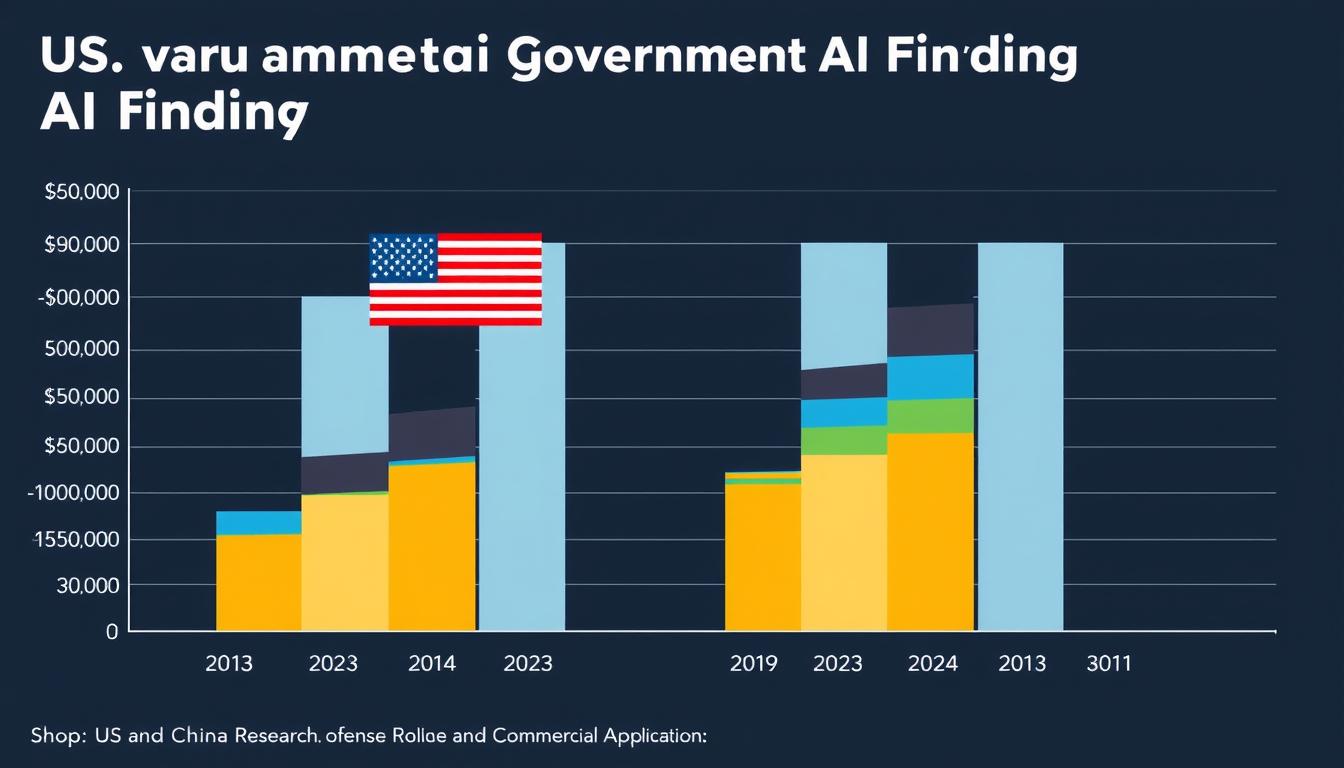
Government artificial intelligence funding approaches differ in scale, focus, and implementation
Government funding patterns reveal different priorities and mechanisms:
US Government Funding
- FY2023 non-defense AI R&D: $1.8 billion
- Defense-related AI funding: estimated $5-7 billion
- Distributed across multiple agencies (NSF, DARPA, DOE, NIH)
- Focus on fundamental research and national security applications
- Public-private partnerships like the National AI Research Institutes
China Government Funding
- Direct central government AI funding: estimated $8-10 billion annually
- Additional provincial and municipal funding: $7+ billion
- Government guidance funds with AI focus: $25+ billion
- Subsidies and tax incentives for AI companies
- Coordinated funding through national AI plans
China’s government funding for artificial intelligence appears to exceed US federal funding, particularly when accounting for provincial and municipal investments. However, the US system leverages significant private sector investment that often builds upon federally funded research, creating a different but highly effective innovation ecosystem.
Investment Trends: Recent data shows US investment increasingly focused on generative AI and foundation models, while Chinese investment has shifted toward applied AI in manufacturing, transportation, and healthcare—areas less affected by US export controls on advanced semiconductors.
Talent and Education

The competition for artificial intelligence talent represents a critical dimension of US-China tech rivalry
Human capital represents perhaps the most critical resource in artificial intelligence development, with both countries implementing strategies to develop, attract, and retain top AI talent.
AI Education Systems
US AI Education
- World-leading computer science programs (Stanford, MIT, CMU, Berkeley)
- Strong integration between academia and industry
- Emphasis on creativity and interdisciplinary approaches
- Declining domestic STEM student numbers
- Heavy reliance on international students (over 70% of AI graduate students are international)
China AI Education
- Rapidly improving universities (Tsinghua, Peking, Shanghai Jiao Tong)
- Massive scale of STEM graduates (1.3+ million engineering graduates annually)
- National AI talent development plan
- Integration of AI into earlier education stages
- Growing but still developing research quality
AI Workforce
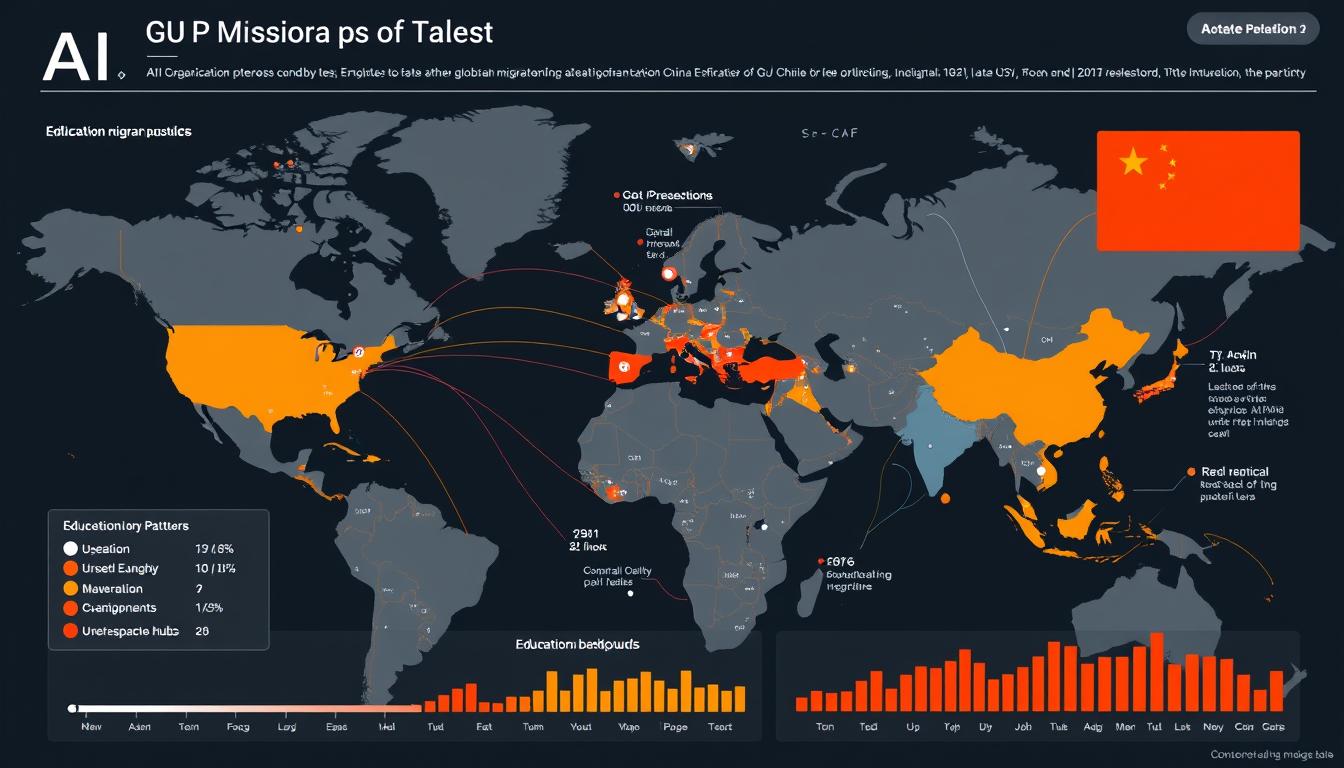
Global artificial intelligence talent flows significantly favor the United States despite China’s growing domestic capacity
The global distribution of AI talent continues to favor the US, though China is rapidly developing its domestic talent pool:
| Talent Metric | United States | China |
| AI Professionals (2023) | ~850,000 | ~600,000 |
| Top-tier AI Researchers | 59% of global total | 11% of global total |
| AI PhD Production (annual) | ~2,000 | ~3,500 |
| International Students in AI | Net importer | Net exporter |
| Industry-Academic Mobility | High | Moderate but increasing |
Talent Migration Patterns
Talent flows between the countries reveal important dynamics:
- Chinese AI researchers continue to seek graduate education in the US, with approximately 20-30% remaining in the US after graduation
- US visa restrictions and growing opportunities in China have increased return rates of Chinese AI talent
- The “Thousand Talents” and similar programs actively recruit overseas Chinese researchers to return
- US companies maintain significant AI research labs in Canada and Europe partly due to immigration constraints
- Both countries face challenges in attracting global talent due to geopolitical tensions
“The competition for AI talent has become as important as the race for AI technology itself. Countries that can attract and retain top AI researchers will have significant advantages in the next wave of innovation.”
Challenges and Future Outlook
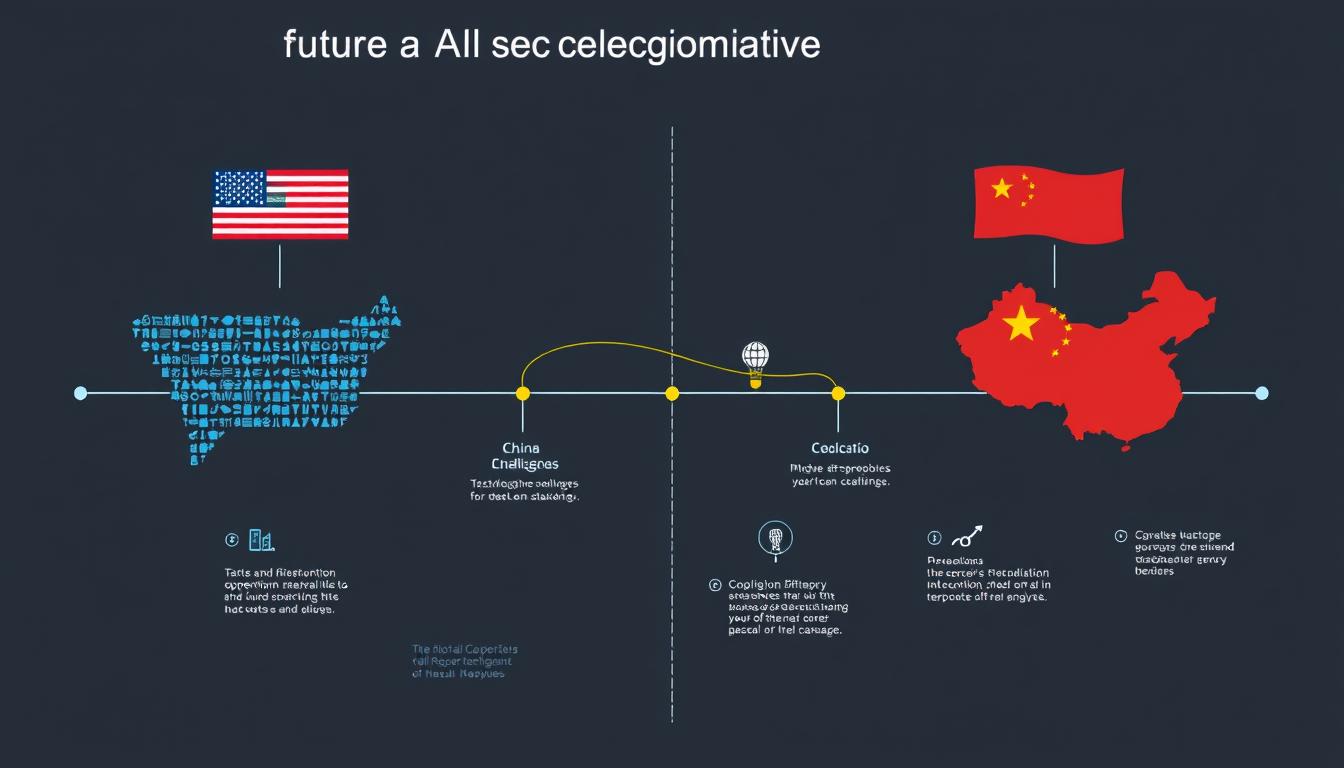
Both nations face distinct challenges in artificial intelligence development amid growing geopolitical tensions
As the artificial intelligence competition intensifies, both countries face significant challenges that will shape the future trajectory of AI development and deployment.
Key Challenges
US Challenges
- Talent pipeline concerns: Declining domestic STEM education outcomes
- Immigration barriers: Difficulties retaining international AI talent
- Regulatory uncertainty: Balancing innovation with growing calls for AI oversight
- Public trust issues: Addressing concerns about AI bias, privacy, and job displacement
- Manufacturing capacity: Limited domestic production of AI hardware
- Sustaining research funding: Maintaining long-term investment in fundamental AI research
China Challenges
- Semiconductor restrictions: US export controls limiting access to advanced AI chips
- Research quality gap: Still developing capacity for breakthrough fundamental research
- International collaboration barriers: Reduced access to global research community
- Regulatory constraints: Balancing control with innovation needs
- Brain drain concerns: Competition for top talent with US institutions
- International trust deficit: Concerns about data privacy and dual-use applications
Geopolitical Dimensions

The artificial intelligence competition increasingly shapes broader geopolitical dynamics
The technology competition has become inseparable from broader geopolitical tensions:
- Export controls: US restrictions on advanced semiconductor exports to China
- Investment screening: Both countries increasing scrutiny of cross-border tech investments
- Alliance building: US forming technology partnerships (AUKUS, Quad) with AI components
- Standards competition: Competing visions for global AI governance and technical standards
- Digital sovereignty: Growing emphasis on domestic control of critical AI infrastructure
Future Trajectories
Several potential scenarios could emerge from the current competitive dynamics:
Scenario 1: Bifurcated AI Ecosystems▶
The most likely near-term scenario involves increasingly separate AI development paths, with limited technological exchange. The US would maintain advantages in fundamental research and cutting-edge applications, while China would focus on applied AI in domains less dependent on advanced semiconductors. This scenario features competing standards, protocols, and governance models, with third countries forced to choose between ecosystems.
Scenario 2: Managed Competition▶
A more optimistic scenario would involve establishing guardrails around AI competition, with agreements on responsible development, safety standards, and limited cooperation on global challenges like climate change and pandemic response. This would require both sides to recognize mutual interests in preventing uncontrolled AI risks while maintaining competitive innovation.
Scenario 3: AI Arms Race Intensification▶
A more concerning trajectory would see AI development increasingly focused on military and security applications, with accelerated investment in autonomous weapons systems and AI-enabled warfare capabilities. This scenario would feature minimal transparency, heightened security concerns, and increased risks of miscalculation.
“The US-China AI competition will define not just technological leadership but the fundamental rules and values that govern how these powerful technologies shape society. The stakes extend far beyond economic advantage to the very nature of political and social organization in the digital age.”
Conclusion
The artificial intelligence competition between the United States and China represents one of the most consequential technological rivalries in modern history. Rather than a simple race with a clear winner, this multifaceted competition features distinct advantages for each country across different domains of AI development and application.
The United States maintains leadership in fundamental AI research, top-tier talent, semiconductor design, and generative AI capabilities. Its innovation ecosystem benefits from world-leading universities, robust venture capital, and dynamic private sector companies. However, it faces challenges in coordinating national strategy, addressing regulatory uncertainty, and maintaining its talent pipeline.
China has achieved remarkable progress in applied AI domains like computer vision and speech recognition, benefiting from massive data resources, coordinated government support, and rapid deployment capabilities. Its challenges include restrictions on advanced semiconductor access, gaps in fundamental research, and limited international collaboration opportunities.
As this competition evolves, policymakers, business leaders, and researchers must navigate a complex landscape where cooperation on global challenges like AI safety must coexist with strategic competition. The decisions made by both countries will shape not just their relative positions but the global trajectory of artificial intelligence development for decades to come.















